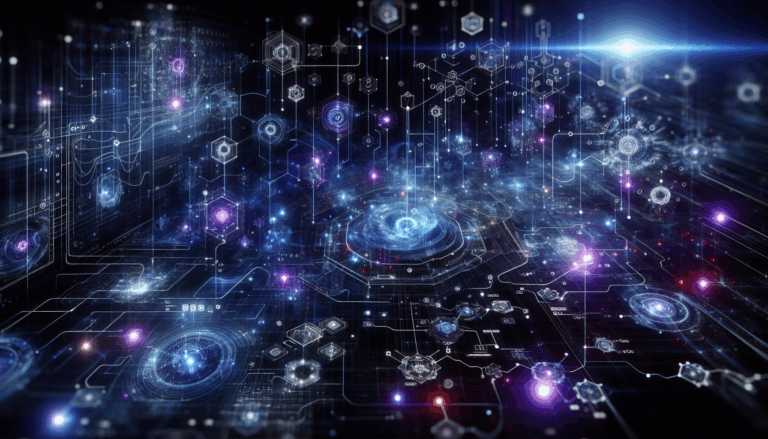What is Retrieval-Augmented Generation (RAG)?
Retrieval-Augmented Generation, often abbreviated as RAG, is an emerging paradigm in the world of natural language processing (NLP) that enhances the capabilities of large language models (LLMs) like GPT-4 and BERT. What sets RAG apart from traditional LLM architectures is its ability to combine knowledge retrieval from external sources with the generative powers of neural networks. This hybrid approach allows LLMs to provide more accurate, up-to-date, and contextually relevant responses.
At its core, RAG works by integrating two main components: a retriever and a generator. The retriever component searches and retrieves relevant documents or data snippets from vast repositories of information—sometimes called “knowledge bases” or “corpora”—based on the user’s prompt or query. Once the most relevant pieces of information are pulled, the generator component synthesizes this material to craft a coherent, informative response.
This architecture provides a powerful solution to one of the biggest challenges in LLMs: their static knowledge base. While the training data for models like GPT-4 is extensive, it has a fixed cutoff date and cannot be updated in real-time. RAG sidesteps this limitation by tapping into dynamic, constantly-updated knowledge sources—think scientific journals, news articles, or corporate databases—allowing the AI to “know” things beyond its original training. For a deeper dive into the architecture behind RAG, you can explore this article by Microsoft Research.
- Step 1: Query Understanding
The process begins when a user poses a query. The system encodes this question or prompt in a way that allows it to search external databases effectively. - Step 2: Information Retrieval
The retriever scours one or more knowledge bases, using similarity algorithms to find passages or documents most relevant to the query. Techniques like dense passage retrieval or vector search models are often used here. For an example of these techniques, see Dense Passage Retrieval for Open-Domain Question Answering by Facebook AI Research. - Step 3: Contextual Generation
The retrieved documents are passed to the LLM, which then generates a fluent and context-aware answer, drawing directly from the retrieved information so that responses can reference the very latest facts or discoveries.
RAG models are especially valuable in applications like intelligent search engines, customer support bots, and research tools where accuracy, recency, and context are paramount. For instance, consider a medical chatbot powered by RAG—when asked about the latest guidance on a rare disease, the retriever can pull clinical trial updates or guidance from sources like PubMed Central, and the generator can explain the findings in everyday language.
By combining knowledge retrieval with language generation, RAG not only expands the utility of LLMs but also enhances their reliability. This ensures that users always have access to the most up-to-date and relevant information, eliminating the risk of “stale” or outdated answers that are common with traditional LLMs.
Why Traditional LLMs Fall Short
For all their remarkable progress, traditional large language models (LLMs) like GPT-3 and its contemporaries have notable limitations when it comes to providing reliable, up-to-date, and domain-specific answers. The heart of the problem lies in how these AI models are trained and how they access (or fail to access) new knowledge.
LLMs are essentially gigantic pattern-matching engines. They’re trained on a massive dataset of text taken from sources like books, websites, and Wikipedia—often collected months or even years before the model goes live. This inherent time lag means they aren’t aware of recent events, emerging research, or breaking news. For instance, querying a traditional LLM about chatbot hallucinations might yield decent background information, but the latest findings from 2024 conferences would be missing entirely.
This static nature also limits how well traditional LLMs can answer deep, niche, or specialized questions. If you seek guidance on a new regulatory rule or an obscure medical guideline, the model’s response may be outdated, generic, or even inaccurate. Without access to external, curated data sources, the model tends to “hallucinate” facts—generating answers that sound plausible but have no basis in reality. Numerous studies, like this Nature article on large language models and factuality, detail the risks of such fabricated answers, especially in high-stakes fields like healthcare and law.
Furthermore, traditional LLMs are unable to provide citations or references for their statements. The information they surface is amalgamated from countless documents, not tied to a specific source. This makes it difficult for users to verify claims or trust the results—an acute problem for anyone making critical business, educational, or regulatory decisions. Imagine asking for the latest tax requirements and receiving an answer based on five-year-old training data, with no apparent way to inspect or update the knowledge.
Because of these drawbacks, developers rely on creative “prompt engineering” and fine-tuning to nudge better output from static models, but these are band-aid solutions. When reliability, explainability, and up-to-date knowledge are paramount, something more robust is needed—setting the stage for new architectures and retrieval-augmenting techniques.
How RAG Works: A Step-by-Step Breakdown
At its core, Retrieval-Augmented Generation (RAG) combines the capabilities of large language models (LLMs) with information retrieval systems. This hybrid approach addresses one of the primary limitations of LLMs: their tendency to hallucinate or generate information that isn’t grounded in real, up-to-date facts. RAG ensures responses are not only fluent but also factual, relevant, and verifiable. Here’s a step-by-step breakdown of how RAG works, with detailed examples for clarity.
1. User Query Received
The process begins with a user posing a question or request. This input could range from technical research queries to general knowledge questions. For example, a user might ask, “What are the latest advancements in quantum computing?”
2. Query Embedding and Search
The LLM converts the user’s question into a numerical representation called an “embedding.” This process helps the system match the user’s intent to the most relevant documents in a vast knowledge base.
To understand embeddings better, check out this overview from Google Developers. Once the query is embedded, a search engine—often powered by dense retrieval models such as Dense Passage Retrieval (DPR) from Meta AI—locates the top documents, passages, or articles that most closely relate to the original query.
3. Document Selection and Ranking
The retrieved documents are then ranked based on their relevance to the user’s question. Advanced ranking algorithms, such as BM25 or cross-encoders, ensure that the most pertinent sources rise to the top. This ranking process is crucial: a high-quality answer depends on precise sourcing from trustworthy and contextually relevant materials.
4. Context Assembly
The system then constructs a context window by packaging together the selected excerpts. This context, often comprising a handful of key passages, is supplied to the language model as external knowledge. For instance, if the user asked about quantum computing, the context might include snippets from recent Nature journal articles or whitepapers.
5. Generation of Answer
Now, the magic happens. Unlike traditional LLMs that rely solely on their training data, a RAG model uses the assembled real-world context as guiding evidence. The LLM synthesizes the answer, weaving retrieved facts into its response. The result is not just a grammatically correct answer, but one that is anchored in up-to-date, credible information.
6. Optional: Source Attribution
For enhanced trust, RAG systems can provide citations or references to the materials used for the answer. This is particularly valuable in scenarios that demand verifiable accuracy, such as scientific research or healthcare guidance. Such traceability not only bolsters user confidence but also helps to combat misinformation.
7. Continuous Improvement
Feedback loops are integral to modern RAG deployments. User feedback on the relevance and accuracy of answers helps refine both the retrieval mechanisms and the generation components. Cutting-edge research in this field is available from sources like arXiv, highlighting active advancements in RAG architecture and evaluation.
In sum, RAG’s approach leverages the best of both worlds—combining the language fluency of LLMs with the precision of search—and represents a major leap forward in the quest for reliable and useful AI-generated content.
Key Benefits of Implementing RAG
Implementing Retrieval-Augmented Generation (RAG) provides a transformative enhancement to how Large Language Models (LLMs) work, making them notably more powerful and practical for real-world applications. RAG combines LLMs with an external search or knowledge base, so the model not only generates responses but also pulls in up-to-date, factual information. Let’s explore the core advantages of this hybrid approach with detailed explanations, actionable steps, and practical examples.
1. Dramatically Improved Factual Accuracy
One of the fundamental challenges of relying solely on LLMs is their tendency to “hallucinate” information, generating content that may sound plausible but is factually incorrect. By integrating a retrieval system, RAG ensures answers are grounded in real, referenceable data. For example, when handling a query about the latest medical research, a RAG-empowered LLM can pull recent clinical trial results instead of relying on outdated or generalized training data. This step-by-step grounding in verifiable sources significantly increases trust in responses.
2. Enhanced Domain Adaptability
Traditional LLMs are limited to the knowledge encoded until their last training run. In contrast, RAG enables models to draw on specialized or private data sources in real time. For instance, a financial analyst might need the latest SEC filings or stock market updates. By configuring a RAG workflow to index these datasets, you ensure expertise isn’t static—it evolves as new data becomes available, making the LLM highly adaptable for industry-specific applications.
3. Scalability and Efficiency in Information Retrieval
With RAG, instead of forcing the LLM to memorize all details, relevant knowledge can be stored externally in a search-optimized database. This reduces computational load and boosts scalability. For example, an ecommerce chatbot doesn’t need to be retrained for every product update. Instead, its knowledge base is refreshed, allowing instant access to the latest catalog information. Interested readers can learn more about optimizing knowledge retrieval from leading AI research institutions like DeepLearning.AI.
4. Transparency and Source Attribution
A notable issue with LLM-generated outputs is a lack of transparency about where information comes from. RAG architectures can return not just answers, but also highlight the sources used—be it documentation, research papers, or company wikis. For regulated industries where auditability is crucial, such as healthcare and finance, this provenance tracking is invaluable. A well-configured RAG system can append links or citations along with its responses, increasing user confidence and regulatory compliance. For more about this, see the discussion by MIT Technology Review on RAG’s implications for trustworthy AI.
5. Reduced Model Size and Maintenance Overhead
Because RAG models defer much of the knowledge representation to external sources, you don’t need to continually “fine-tune” or excessively scale up your primary LLM as new content arrives. Updates and corrections happen at the database or search index level. For organizations handling vast or rapidly changing datasets, this means substantial cost and resource savings compared to running ever-larger LLMs. For instance, updating a university’s knowledge base about COVID-19 policies is far simpler and faster with RAG than retraining the AI itself. For further reading, Meta’s AI blog explains their approach to RAG at scale.
In summary, RAG is the backbone of truly practical LLMs, unlocking applications that demand accuracy, adaptability, efficiency, and transparency. Organizations seeking to deploy AI responsibly and at scale overwhelmingly benefit from adopting the RAG paradigm.
Real-World Applications of RAG-Powered LLMs
The emergence of Retrieval-Augmented Generation (RAG) models has revolutionized the landscape of large language models (LLMs), enabling them to provide practical, context-aware solutions to real-world problems. By seamlessly blending LLMs’ generative capabilities with powerful information retrieval systems, RAG acts as a bridge between static pretrained knowledge and up-to-date, domain-specific data. Here’s an exploration of how RAG technology is transforming different industries with concrete use cases and clear steps illustrating its impact.
Customer Support Automation
Modern customer service relies on accurate, rapid, and personable responses. Traditional chatbots often falter when queried about recent product updates or policies. RAG-powered LLMs, however, are changing the game. These systems pull relevant documents, FAQs, or knowledge base articles from a company’s real-time database and use this retrieved content to formulate precise and current responses.
- Step 1: The customer asks a specific or complex question.
- Step 2: The RAG model retrieves the latest internal documentation or records pertaining to the inquiry.
- Step 3: The LLM generates a conversational, personalized answer based on the retrieved data.
This dual-engine approach significantly reduces hallucination (making up facts) by anchoring responses in verified information. Studies and deployments at companies like OpenAI and Google DeepMind demonstrate how RAG models outperform traditional generative AI in trustworthiness and user satisfaction.
Healthcare Decision Support
In healthcare, timely and accurate information can save lives. Medical professionals are leveraging RAG to automatically surface the most relevant portions of medical literature, clinical guidelines, and patient records when answering queries or making clinical decisions.
- Example: A doctor wants to confirm the latest treatment protocol for a rare disease. RAG-enabled LLMs instantly scan trusted databases such as PubMed or institutional guidelines, pulling the most up-to-date recommendations for the LLM to reference in its advice.
- Step-by-step:
- Query is submitted by the clinician.
- RAG retrieves and ranks documents based on relevance from medical repositories.
- The LLM summarizes and contextualizes findings, presenting actionable insights with source attributions.
This method ensures practitioners get both the breadth of AI language understanding and the depth of credible, real-world medical data, as explained in detail by experts at Mayo Clinic.
Enterprise Knowledge Management
Corporations are flooded with internal documentation—project specs, meeting notes, compliance guidelines—that are often siloed and hard to navigate. RAG-enabled applications let employees “ask anything” and get consolidated, up-to-date answers culled from an organization’s entire knowledge base.
- Step 1: An employee submits a query, such as “What is the process for submitting a travel reimbursement?”
- Step 2: The RAG model fetches the latest policy documents, process records, and even recent email threads.
- Step 3: The LLM fuses all this content into a concise, actionable summary with clear step-by-step instructions, referencing sources as needed.
Industry leaders are showcasing these advancements at conferences and in whitepapers, such as this McKinsey analysis on generative AI in the workplace.
Legal Research and Compliance
Law firms face the challenge of sifting through vast amounts of regulatory documents, case law, and statutes to build cases or ensure compliance. Traditional search tools are limited by exact keyword matches or require tedious manual review. RAG-powered LLMs change this by allowing nuanced, context-based searches and generating legal summaries that cite the precise sections of laws or rulings.
- Example: An attorney needs a summary of recent antitrust decisions. By inputting the query into a RAG-powered system, the model pulls relevant passages from official court opinions (see Courthouse Library) and generates a digest with in-line citations.
- Benefit: Faster, more accurate legal research with full traceability, saving billable hours and reducing risk of oversight.
Enhancing Educational Tools
Educational platforms increasingly use RAG LLMs to provide students with up-to-date, factually accurate answers, tailored explanations, and even sourcing from academic articles. Imagine a student preparing for a debate or writing a research essay; instead of static textbook answers, they receive a dynamic, well-cited response compiled from trusted academic sources such as Google Scholar.
- Example Steps:
- Student asks a specific question about climate change or a historical event.
- RAG retrieves the latest peer-reviewed papers or primary sources.
- The LLM produces a nuanced answer with suggested reading for further study.
This approach helps foster critical thinking and independent research skills, with proven efficacy outlined in studies from institutions like Stanford University.
These examples only scratch the surface. As LLM technology continues to evolve, the injection of real-world, current information through RAG will be indispensable to industries seeking reliability, accuracy, and depth from AI-powered applications. By rooting responses in trusted, external data, RAG ensures that generative AI not only imagines possibilities but delivers results grounded in reality.
Challenges and Considerations in RAG Deployment
Deploying Retrieval-Augmented Generation (RAG) systems holds immense promise for enhancing the usefulness of Large Language Models (LLMs) by grounding their outputs in reliable data. However, the journey from experimentation to production is riddled with practical challenges and crucial considerations. Below, we explore the main hurdles and best practices to navigate them.
Data Quality and Retrieval Effectiveness
At the heart of RAG lies the ability to retrieve accurate and relevant information from the external datastore. Poor-quality or outdated data can undermine the entire system. Start with meticulous data curation:
- Deduplicate and clean datasets: Remove redundancies and errors to ensure reliability.
- Constant updating: Implement pipelines for frequent data refreshes, ensuring your knowledge base evolves alongside new developments.
- Index and search strategies: Experiment with vector stores and ranking techniques to boost retrieval precision, as illustrated in studies from Google Research.
Failure to address these steps can result in hallucinations or, worse, the spread of misinformation.
Cost and Latency Management
Latency and computation cost can spiral with complex retrieval pipelines and large LLMs. There are strategic optimizations you should consider:
- Batch requests: Group multiple retrieval queries to reduce overhead.
- Local vs. cloud inference: Weigh the tradeoff between running inference on-premises for speed, versus leveraging the flexibility and scale of cloud providers (Azure’s RAG solutions provide useful benchmarks).
- Result caching: Cache frequent retrievals to improve response times and minimize repeated operations.
Alignment and Security Risks
RAG systems inherit not only the risks of LLMs, such as bias and toxic output, but also add new attack surfaces:
- Context injection threats: Malicious actors could pollute retrieval databases. Employ strict data governance and monitor updates.
- Bias amplification: Regularly audit retrieval datasets for skewed representation and methodology. For example, Nature highlights the risk of bias in AI systems, which is equally critical in RAG deployments.
Perform adversarial testing and use security tools to monitor for emerging threats.
Evaluation and Monitoring in Production
Continuous evaluation ensures your RAG deployment maintains high utility and trustworthiness:
- Automated eval suites: Deploy end-to-end tests that simulate real-world queries and score outputs for faithfulness and factuality, as recommended by academic resources like FAIR’s work on evaluation.
- Human-in-the-loop processes: Regular audits from domain experts can detect subtle issues automated systems may miss.
- Feedback loops: Encourage user feedback for continual improvement, adapting your retrieval strategies accordingly.
Scalability and Customization
As your application grows, so do the expectations for serving more users and accommodating various domains:
- Horizontal scaling: Design your infrastructure so databases, retrieval modules, and LLM endpoints can elastically scale. Industry leaders like AWS provide blueprints for doing so at scale.
- Domain adaptation: Establish fine-tuning routines that periodically refresh both retrieval and language model components for different industries or knowledge domains.
Taking these steps to heart ensures your RAG deployment is robust, efficient, and safe, ultimately transforming LLMs from impressive demos to truly useful and trusted enterprise assets.




